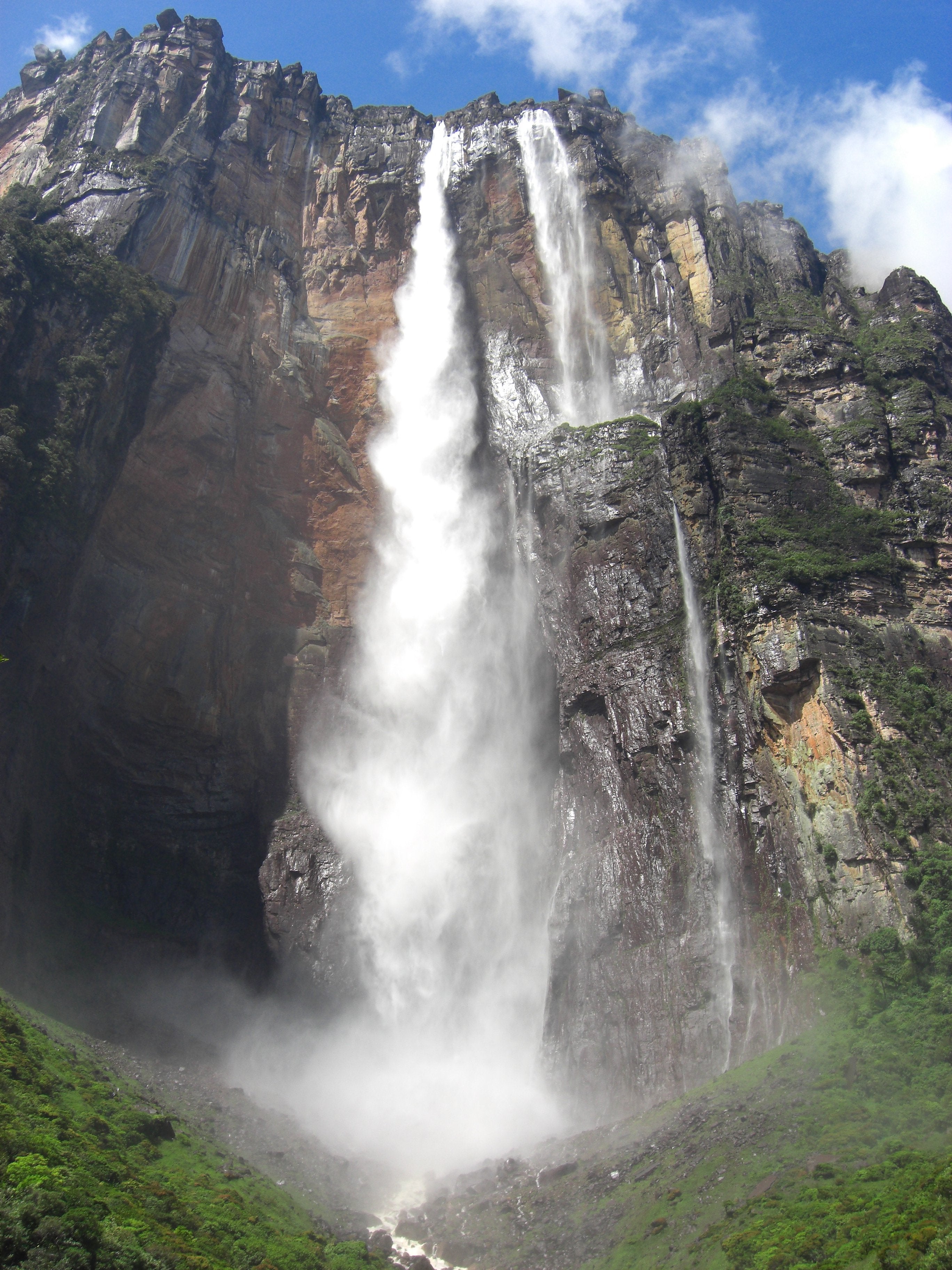
Credit: Diego Delso (CC BY)
The waterfall. In concept, it’s simple: just water… falling.
But in life, waterfalls are a wonder.
Beautiful, frightening, powerful, calming, deafening, soothing—sometimes all at once. They’ve been inspiring humans for millennia.
When water flows over a wide shelf, it’s called a block falls. The widest is Victoria Falls in Zambia, over one mile across. Called “smoke that thunders” in the local language, it can be heard 25 miles away. Human tools have been found there from 50,000 years ago.
The tallest falls are in Venezuela. Angel Falls cascade down the face of a half-mile-high rock shelf in a horsetail plume that falls so far, the water turns to mist before it can reach the ground. There, the river reforms to continue its path.
Yosemite Falls in California is 200 feet shorter but nearly as spectacular.
But by far, the biggest waterfall in the world is “out of sight”: Water falling into water under more than half a mile of ocean.
Off the coast of Greenland, a huge torrent of dense, very cold water surges over a shelf into the warmer North Atlantic, plummeting 11,000 feet. Its flow is 30 times that of all the rivers that flow into the Atlantic, an astonishing 1.3 trillion gallons per second!
Next time you get out into nature, make it a point to take in a waterfall.
Background
Synopsis: The great waterfalls of the world are wondrous sights, each unique in its own way. Several stand out by virtue of their sheer magnitude of width, average flow volume, and height. But you can’t view Earth’s tallest and most powerful waterfall without a submarine—it’s found underwater between Greenland and Iceland in the Denmark Strait.
- A waterfall occurs when a river or stream descends from a resistant rocky ledge to a lower level, usually forming a plunge pool as it erodes away the rock where it lands.
- Waterfalls occur all over the world but are most common in mountainous areas where rivers are fairly young.
- Waterfalls are defined as abrupt water level drops of 5 ft (1.5 m) or more in a water course, with volumes ranging from trickles to torrents.
- Waterfalls change through time by a process of erosional undercutting, ledge collapse, and upstream retreat of the cascade.
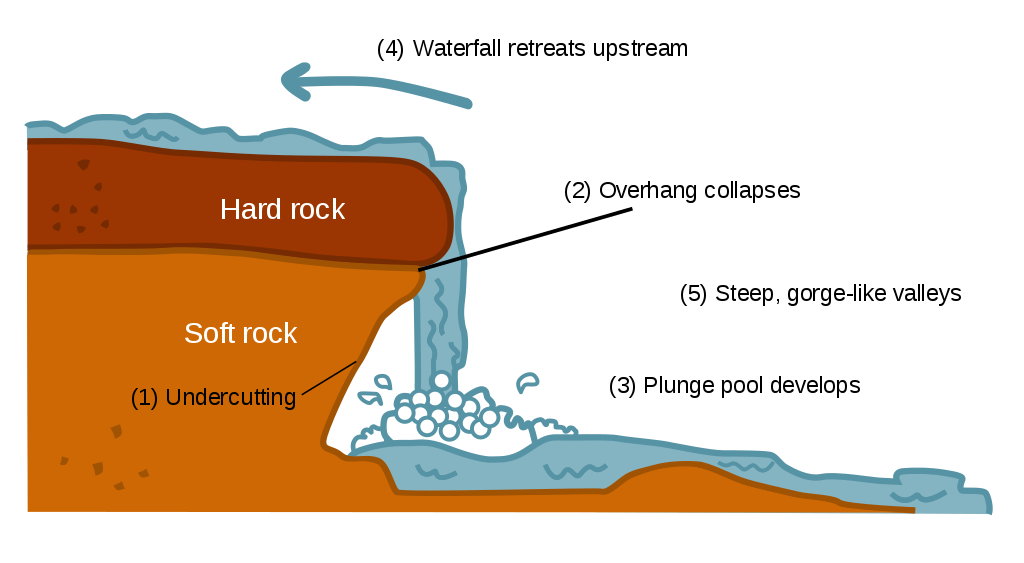
Credit: Cradel (CC BY-SA)
- Waterfalls are made up of segments, called cascades, that may be single-step or multi-step as they drop from the ledge to the plunge pool. Different types of cascades are defined by the way the water falls over the bedrock.
- A plunge occurs when the water loses contact with the rock, descending vertically off of the ledge.
- A chute is a pressurized flow of water caused when a large volume is channeled into a narrow space.
- A cataract is a high-volume thunderous waterfall with strong, dangerous currents.
- A block is a high-volume flow that descends over a very wide ledge.
- A horsetail occurs if the water maintains contact with the bedrock all the way to the plunge pool. If it makes a fan shape, it is called a fan waterfall.
- A punchbowl occurs when water cascades into a very wide plunge pool.
- An ephemeral waterfall may only flow at certain times when liquid water is available in arid or frozen environments.
- There are many additional descriptive names for waterfalls in many languages.
- The world’s widest continuous curtain of water is Victoria Falls, a block waterfall along the Zambezi River on the border of Zambia and Zimbabwe.
- The river crosses a series of faults in a 180-million-year-old basalt flow.
- Its largest cascade drops as much as 354 ft (108 m) in a 5604-ft-long (1708 m) sheet over a large fault and into the narrow Zambezi Gorge, carrying more than 285,000 gal (38,400 cu ft; 1,080,000 L) of water per second.
- It is known in the local dialect as Mosi-oa-Tunya, or “smoke that thunders” because of the huge cloud of mist generated by the plunging waters.
- The water’s roar is so loud it can be heard from 25 mi (40 km) away.
- Human-made tools from as long as 50,000 years ago have been found at the site, along with evidence of hominid presence dating to 1.5–3.0 million years ago.
- In November 1855, Dr. David Livingstone, a missionary and explorer from Scotland, became the first European to find the falls, giving them their European name after Queen Victoria.
- The largest block waterfall in the United States is Niagara Falls, which lies on the border with Canada.
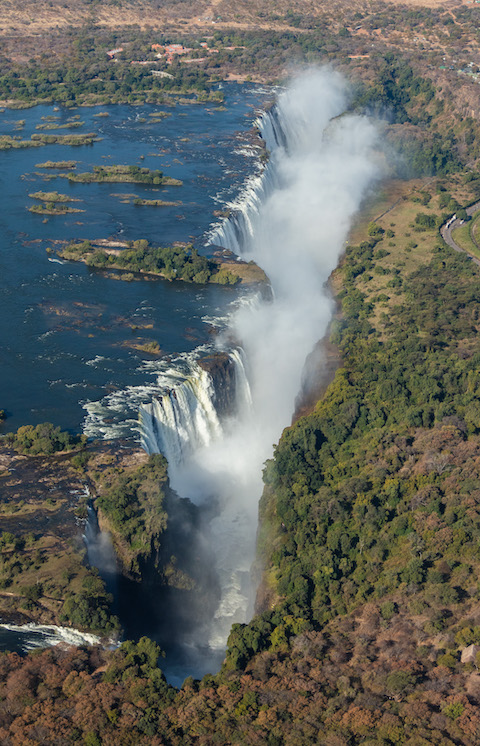
Credit: Diego Delso (CC BY-SA)
- The waterfall with the world’s highest average flow rate depends on local conditions, making it more difficult to assess. The World Waterfall Database makes a case for Wagenia Chutes along the Lualaba River in the Democratic Republic of the Congo (formerly known as Zaire).
- The horsetail falls stretch the entire 0.85 mi (1.4 km) width of the river but only drop 30 ft (9 m) over two equal steps at a flow rate of 4.5 million gallons (600,000 cu ft; 17 million liters) per second.
- The local name for the falls is Kisangani. The European name is Stanley Falls, after Welsh explorer Sir Henry Morton Stanley, who greeted his fellow explorer with the now famous line “Dr. Livingstone, I presume.”
- The two highest-volume waterfalls in the United States (Celilo and Kettle Falls) are now inundated in reservoirs along the Columbia River in Oregon and Washington. Today, Niagara Falls is America’s highest-volume waterfall, averaging 636,000 gallons (85,000 cu ft; 2,407,000 L) per second.
- Earth’s tallest waterfall, a dramatic plunge waterfall, is Salto Ángel (Angel Falls). It flows in eastern Venezuela’s Canaima National Park.
- The falls are known as Kerepakupai Merú in the local Pemon tribal dialect.
- Angel Falls forms as the Río Churún approaches the edge of a sandstone mesa known as Auyán-Tepuí (Devil’s Mesa).
- The river disappears into a sinkhole, drops 100 ft (30 m), then blasts sideways out of the vertical mesa wall, plunging in an uninterrupted 2648-ft (807 m) torrent.
- The drop is so far that the water turns to mist by the time it reaches the valley, where the river reforms and encounters a second drop on its way to the valley floor, accumulating a total fall height of 3212 ft (979 m).
- The average flow is only about 3750 gallons (500 cu ft; 14,200 L) per second, sometimes decreasing to just a thin trickle in the dry season.
- The falls got their European name from Jimmy Angel, an American explorer who crashed his plane nearby on Auyán-Tepuí in 1937.
- The tallest waterfall in the United States is Yosemite Falls, with a drop of 2425 ft (739 m).
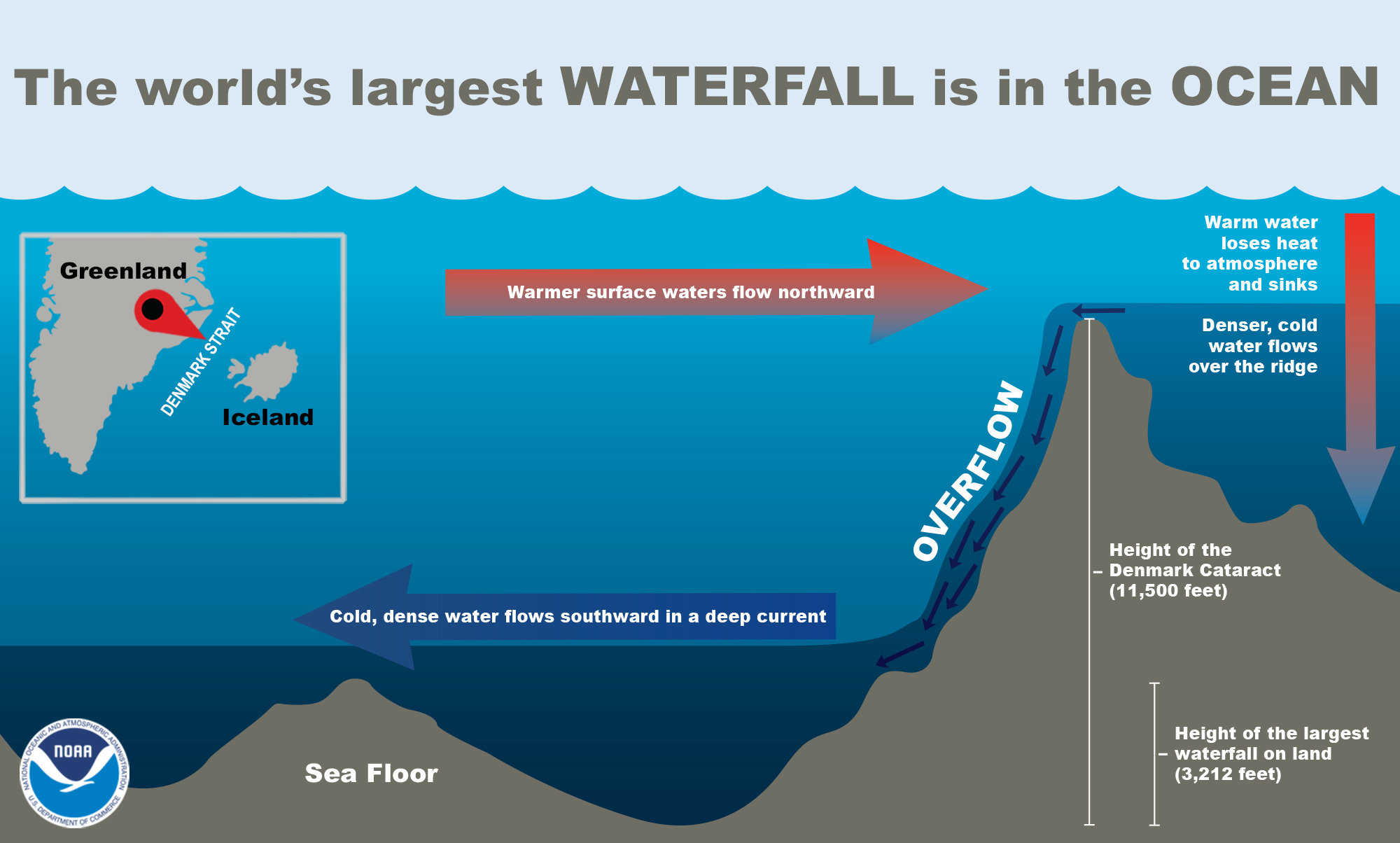
Credit: NOAA
- But if you think of a waterfall from the standpoint of physics—as a flow of denser fluid through a less dense fluid, such as river water through air—then there is an even larger waterfall that drops more than 2 mi (3.5 km), completely hidden from our view.
- It is located 2000 ft (600 m) below the ocean surface between Greenland and Iceland in the Denmark Strait.
- The Denmark Strait Cataract is more than 3½ times taller than Angel Falls.
- Dense frigid water from the Greenland Sea drops at least 11,500 ft (3505 m) toward the southwest into a deep region of the warmer North Atlantic Ocean known as the Irminger Sea.
- Its average flow rate is estimated at an astonishing 1.3 trillion gallons (175 million cu ft; 5 trillion L) of water per second.
- The cataract’s flow is between 20 and 40 times the flow of all river water flowing into the Atlantic Ocean, and its waters drive an important current that flows southward along the ocean floor.
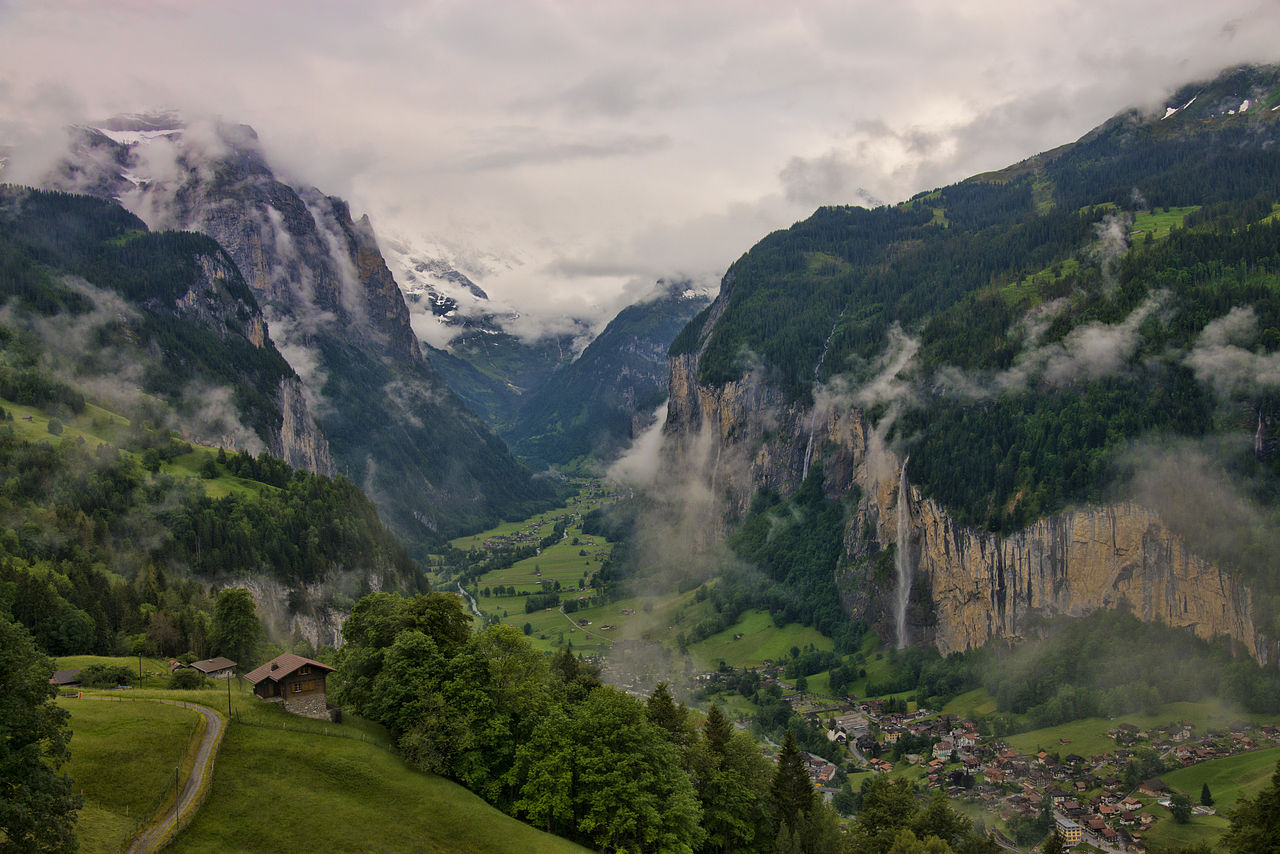
Credit: chensiyuan (CC BY-SA)
- Waterfalls are a delight to observe wherever they are found.
- Look for them in glacial settings also, especially in the spring and summer.

